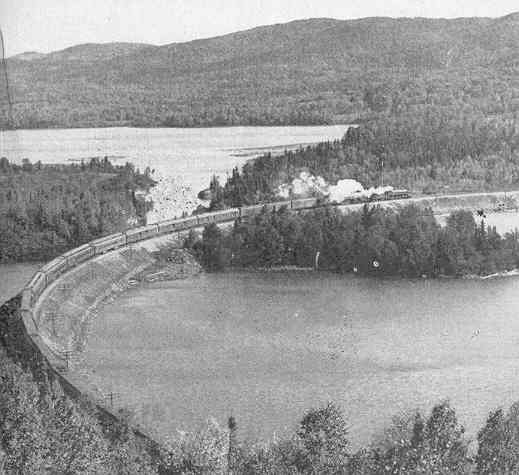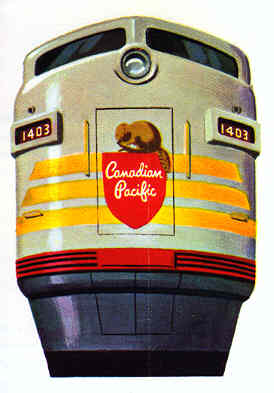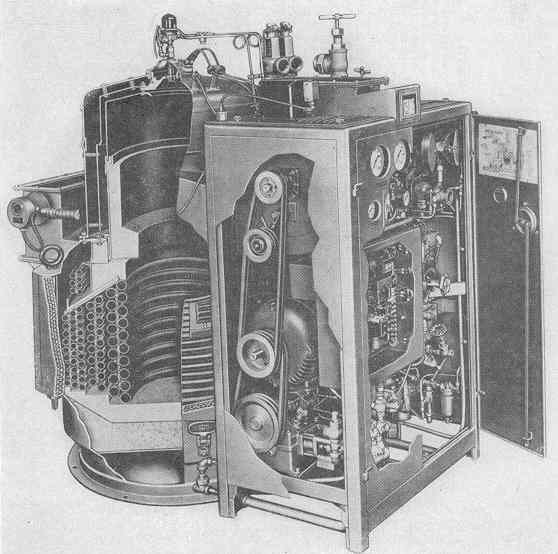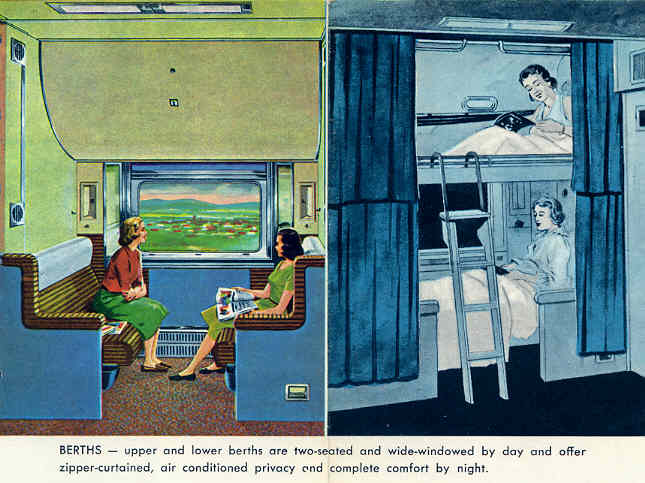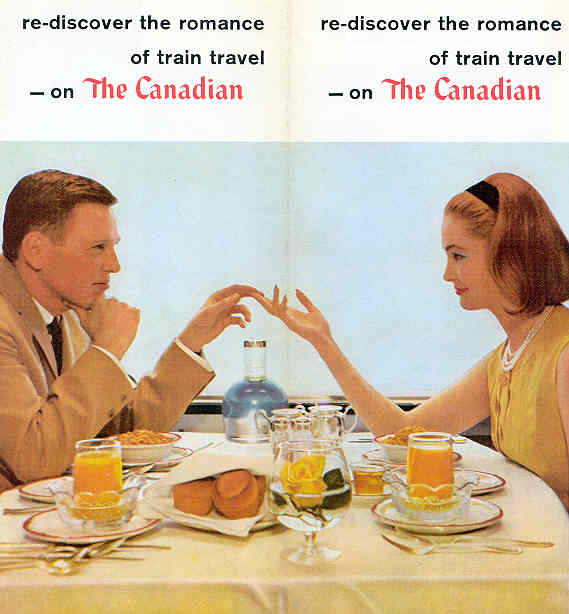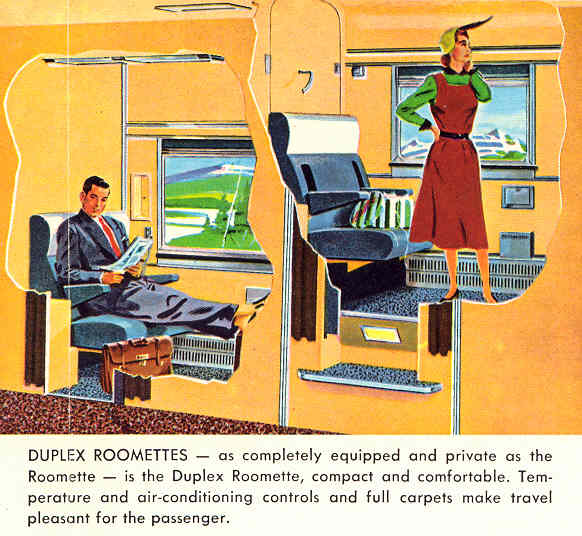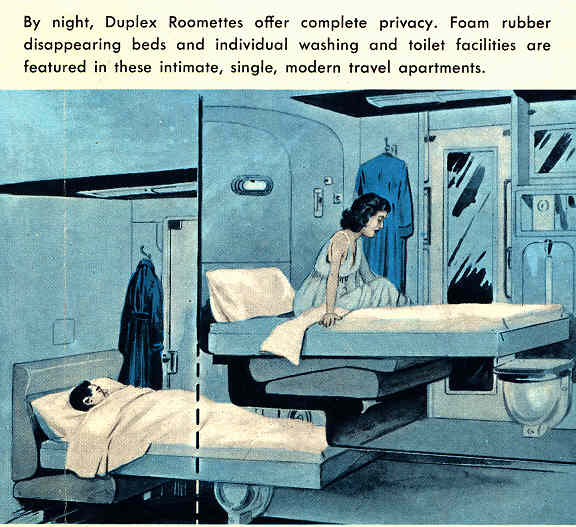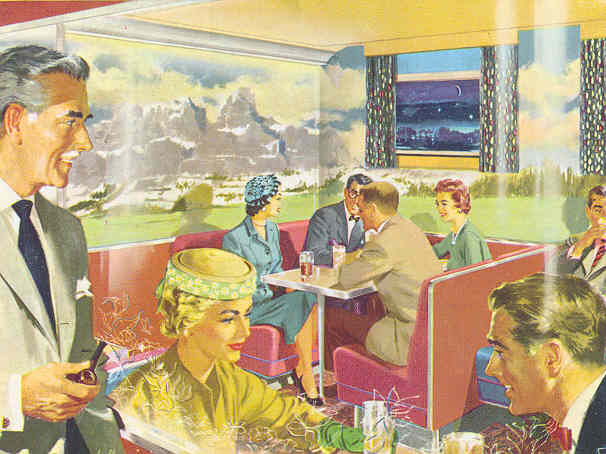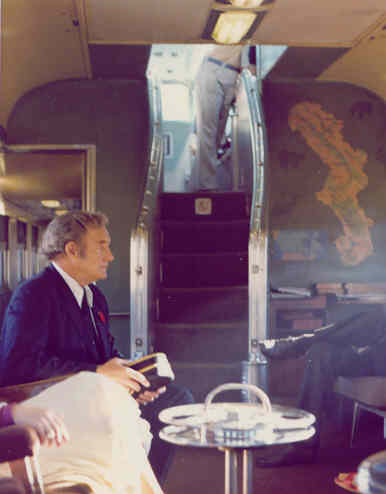By night, the beds have dropped down
from the ceiling and someone gets to sleep in the upper
bunk. Personal reading lights are available with all the
sleeping accommodation we have examined so far.
The Park Car and its Dome
The Park Car was designed to be the signature car of the
train. Its round "boat-tailed" end came complete with an
illuminated translucent "drumhead" which proudly displayed
the train's name and the CPR crest by night.
The Park Cars were named after some of Canada's National
and Provincial Parks - particularly those served by the
CPR.
A Park Car had a poorer domed sibling named a "Skyline"
car, with a snack bar tucked under its dome. The Skyline
was marshaled between the "U" Series and the coaches.
Referred to by a 3-digit
number only, and having neither boattail nor drumhead, the
Skylines
sadly realized that the Park Car was the CPR's favoured
dome in each trainset.
In the diagram below is a Park Car floorplan. Left to
right : there were a few bedrooms; the Mural Lounge (with
the domed
observation area located upstairs and directly over it) ;
and a
lounge in the boattailed end of the car.

Here is an illustration showing a happy 1950s group in
a dome.
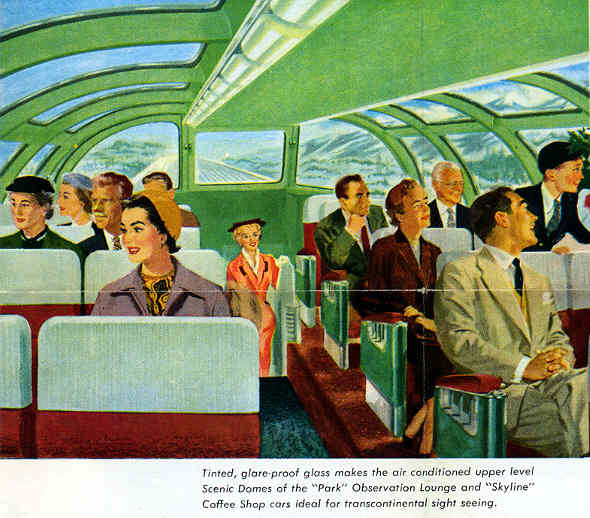
By night, early versions of The Canadian had
locomotive-top spotlights which pointed up and ahead to
illuminate mountains for the dome passengers. Unlike
freights, the trains were often short enough that you
could watch from the rear dome as the headend "knocked
down" the
clear signals as it passed them.
In addition, locomotives were equipped with two steel bar
"icebreakers" to knock down large tunnel icicles before
they took
out the front glass of the Skyline dome - and probably the
passengers
up there as well.
Below is an interior view of the Park rear lounge area.
The seat arrangement was conducive to relaxed conversation
- especially
as there was a bar nearby. The rounded car end gave
passengers a good
wide view of the local geography. If you were so inclined,
the rear
window was excellent for taking photos of the technical
aspects of the
track and railway facilities. The heavy ashtrays shown
lasted for decades
and decades.
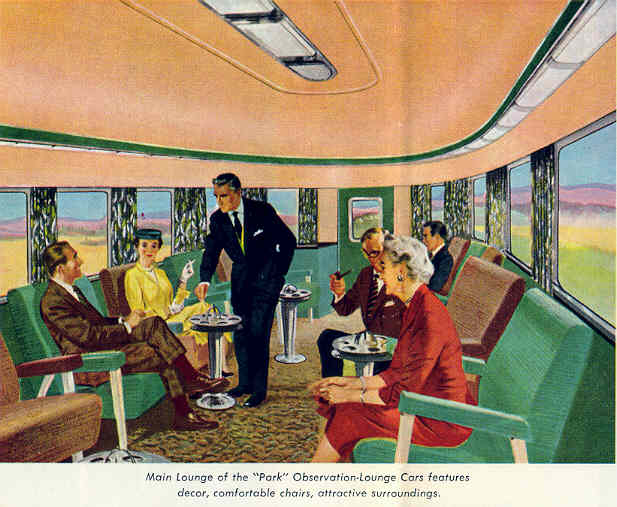
Here is an illustration of the
Mural Lounge bar area displaying the trainset's most
prestigious feature -
and no, it's not the guy with the pipe :
It's the mural ! ...
"covering two walls, signed by a member of the
Royal Canadian Academy of the Arts
".
You can see that calling the train "The Royal Canadian"
would have fit in well with the mural in the signature
car.
In real life, the Mural Lounge was a little more cramped
than it was "intimate as an exclusive club"
as the brochure stated.
Let's explore the layout:
- The
train gigolo distinguished
gentleman with
the pipe is walking from left to right, approaching
the bar entrance and
the boattail lounge area.
- He is looking through the decoratively etched
glass enclosing the Mural Lounge.
- The far, dark scene with the crescent moon is the
view out the window on the right side of the
car. There are three windows
on that side wall of the Mural Lounge - around which
the mural must flow.
- The mountains, blue sky, clouds and trees are
part of the aforementioned mural.
- The mural pictured here does not match any of the
particular murals actually placed in these cars.
This is how they got the murals done:
- Armed with samples of the interior decorating
materials to be used inside the cars, a member of the
Canadian Pacific's design department contacted the
President of the Royal Canadian Academy of the Arts.
- The President, in turn, contacted individual
artists to canvass - sorry - for interest in
the CPR commissions.
- Each mural was to depict the park after which
each car was named.
- Each artist was to produce a mural
... for
the solid wall shown above and around the three
windows' worth of
wall on the right side.
- After completion of a satisfactory preliminary
rendition, the CPR furnished the final materials, cut
to the appropriate dimensions.
- Completed mural canvases were glued to metal
plates, which were rivetted to the cars.
- In addition, each artist was to produce a
map panel showing:
- The park's location in Canada.
- A map of the park.
- Around the edges of this panel : animals and/or
people doing
their usual thing inside the park.
- One source reveals that one artist was paid $1400
in 1954 dollars for his work.
- This was all done under tight time constraints as
the whole mural project was completed in about one
year.
Who participated?
Algonquin Park
|
A.J.
Casson
|
Assiniboine Park
|
Franklin Arbuckle
|
Banff Park
|
Charles Comfort
|
Evangeline Park
|
Leslie Smith
|
| Fundy Park |
Lawren Phillips Harris
|
Glacier Park
|
Adam-Sheriff Scott
|
Kokanee Park
|
A.Y.
Jackson
|
Kootenay Park
|
George Pepper
|
Laurentide Park
|
Albert Cloutier
|
Prince Albert Park
|
Fred Finley
|
Revelstoke Park
|
R.W. Pilot
|
Riding Mountain Park
|
William Winter
|
Sibley Park
|
Yvonne Housser
|
Strathcona Park
|
W.J. Phillips
|
Tremblant Park
|
Edwin
Holgate
|
Tweedsmuir Park
|
E.J. Hughes
|
Waterton Park
|
L. Petely-Jones
|
Yoho Park
|
Harold Beament
|
RED: "Group
of Seven" Member
The Group of Seven began as a
group of seven Canadian artists who held their first
exhibition together in Toronto
in 1920 as an organization of self-proclaimed modern
artists. They felt
they represented a new, more independent, Canadian
approach to painting
- particularly in their paintings of Canadian
landscapes.
On a number of occasions, the CPR supported their
efforts to paint remote Canadian landscape subjects
along the CPR route. It was after such a trip in 1921
to paint along the stark east and north shores Lake
Superior that Lawren Harris (Senior - the father of
the artist who painted the Fundy Park mural) developed
his characteristic style of using radically simplified
colour and painting layouts. A few other artists were
invited to join before the group disbanded in 1933.
From a trip I took in 1979, you can see the map panel
for Kootenay Park to the right of the stairway to the
dome. This photograph is taken from the boattail lounge
of the Park Car and the Mural Lounge is behind the map
panel's bulkhead. At this point, the murals and maps had
been cigarette-smoked and vibrated back and forth across
Canada for
25 years. Notice the indestructible ashtray.
In the early 1980s, VIA Rail removed the murals
from the cars and attempted to restore them. VIA
sponsored a short travelling exhibit of some of the
murals. We drove to Welland, Ontario to see a number of
them on display around this time.
Let's close the knuckles,
connect all the air hoses,
make the steam connections,
plug in the PA wires,
and see what we get.
We get nice publicity shots
like this in the Bow Valley!
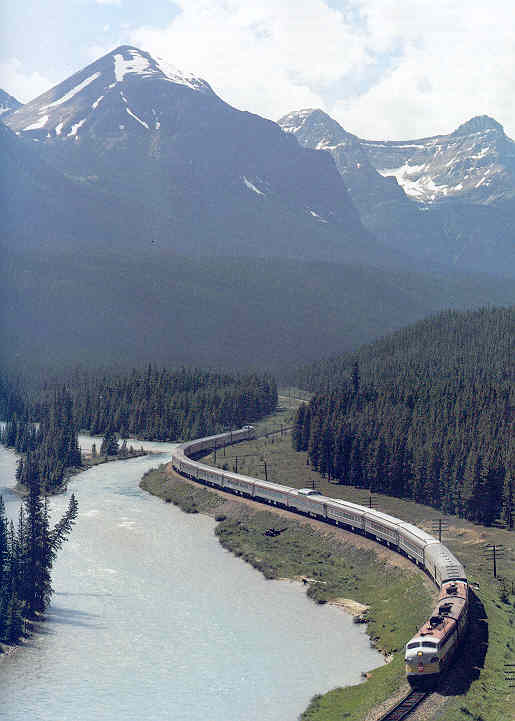
In this early CPR
publicity photo of The
Canadian, you can see:
Conservatively
choosing proven locomotive and
rolling stock designs,
in 1953 the CPR quickly developed a daily
transcontinental train,
using modern passenger equipment which was
unique in Canada.
It faced the formidable competition of postwar
air travel
and the increasing popularity of the
automobile for long distance journeys.
To encourage Canadian and overseas tourists to
ride The Canadian,
the CPR promoted the equipment's features,
the quality of its onboard service,
and the picturesque areas of Canada
which it served.
Distinctive Canadian art was commissioned by
the CPR to decorate the train
and equipment names were intended to recall
450 years of Canadian history.
